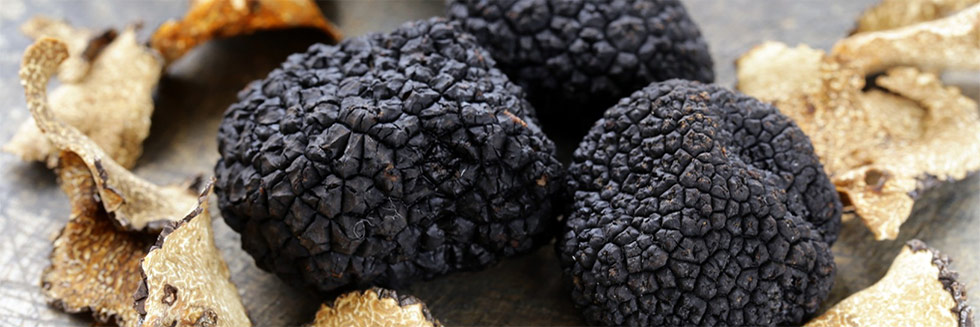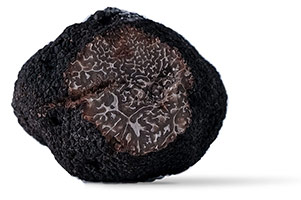
Where and how to produce black truffles ?
Characteristics of the black truffle
 The black truffle, also called Perigord truffle, belongs to the Tuberaceae family. This edible mushroom is called "hypogeous" because it grows underground. It is also a "mycorrhizal" mushroom, which means that the truffle lives in symbiosis with a host tree, most often a holm oak or a white oak.
The black truffle, also called Perigord truffle, belongs to the Tuberaceae family. This edible mushroom is called "hypogeous" because it grows underground. It is also a "mycorrhizal" mushroom, which means that the truffle lives in symbiosis with a host tree, most often a holm oak or a white oak.
Tuber melanosporum is characterized by its rounded shape, sometimes bumpy, and by its black flesh marbled with white. This truffle gives off an intense perfume and reveals fine aromas that make it an exceptional mushroom. Emblematic of French gastronomy, the black truffle can be eaten cooked or raw, as a seasoning or as an accompaniment to a dish. Black truffles mature in winter and are harvested from November to early March..
Soils and climates suitable for the black truffle farming (Tuber Melanosporum)
The black truffle is the most famous in France. Its heat requirements naturally make it prefer southern regions, but it can be found further north, as far as Lorraine where it seems to reach the limit of its production area.
The black truffle grows mainly on calcareous soil, rich in calcium with an optimal pH between 7.8 and 8.3. It grows preferably on well-drained plateaus and gentle slopes, located at an altitude of between 100 and 1000 m. The ideal orientation is south, south-east, south-west, because the sunshine must be maximum for Tuber melanosporum. It adapts particularly to dry and hot conditions, with an alternation of very distinct seasons. The presence of Tuber Melanosporum mycelium in the soil is generally manifested by the appearance of "burns", sometimes very marked and spectacular.
Soils favorable to the development of Tuber melanosporum
The black truffle requires a calcareous soil, rich in calcium and alkaline reaction. The optimal pH is between 7.5 and 8.5 with at least 8% of total limestone. Favorable soils are generally shallow, 15 to 40 cm, on cracked rock, with a lumpy or sandy structure. They must be well balanced in mineral elements and organic matter: the carbon/nitrogen (C/N) ratio must be close to 10. Avoid compact soils with too much clay texture: 30 to 35% is the limit. The soil must be draining.
We remind you that each truffle species has specific requirements. This is why we advise you to have a soil analysis done to check if your land is suitable for truffle growing and to define the most suitable truffle species. We can arrange for this analysis to be carried out by our partner, the Teyssier laboratory, which specializes in soil analysis for truffle growing.
Preferred climate for the black truffle
Generally speaking, truffle cultivation requires a temperate climate. It will develop all the more easily if it benefits from the following conditions: a not too dry spring without late frost, a hot summer with dry periods limited to 3 weeks, a mild autumn without early frost and a winter without intense cold. It is important to keep in mind that the black truffle is harvested in winter, at a shallow depth, and that it can therefore freeze... It also needs a soil that warms up well in spring, when the mycelial activity starts.
Irrigation and water needs of the black truffle
Like any other mushroom, the black truffle needs water especially during its development. Indeed, the small truffles are very sensitive to a strong drying of their close environment. It is therefore necessary to limit the drying out of the soil without overwatering, which is also to be avoided. One should therefore be satisfied with moderate but regular watering (every three weeks in the absence of significant rainfall): 15 to 25 liters of water per tree to be distributed over 1.5 m² at the foot of the tree. Be careful, drip irrigation is to be avoided, it is better to use "rain" watering or sprinkling or micro-sprinkling, localized at the foot of the young plants, only to compensate for the lack of natural rainfall.
Mycorrhization of forest trees by the black truffle
Naturally, many forest species can live in symbiosis with the black truffle. The best known are the oaks and hazelnut trees, but it is quite possible to produce black truffles from many other species of trees such as hornbeam, pine or even lime. Indeed, each of these species responds favorably to controlled mycorrhization, so that you now have the possibility to grow black truffles from mycorrhized plants.
If the two most used host species for the cultivation of black truffles remain the truffle oaks and the truffle hazelnut trees, Robin Nurseries offers a much wider range of host species. This wide choice of ROBIN TRUFFLE PLANTS allows us to adapt to the different constraints and conditions encountered in the field (climate, exposure, altitude, hygrometry...).
Below, you will find all the host species proposed by ROBIN Nurseries after mycorrhization with the black truffle :
- Turkey oak mycorrhized with black truffle
- Kermes oak mycorrhized with black truffle
- Pedunculate oak mycorrhized with black truffle
- Pubescent oak mycorrhized with black truffle
- Evergreen oak mycorrhized with black truffle
- Common hazelnut mycorrhized with black truffle
- Turkish hazelnut tree mycorrhized with black truffle
- Atlas cedar mycorrhized with black truffle
- Common hornbeam mycorrhized with black truffle
- East hornbeam mycorrhized with black truffle
- Rockrose mycorrhized with black truffle
- Aleppo pine mycorrhized with black truffle
- Austrian black pine mycorrhized with black truffle
- Basswood mycorrhized with black truffle
Thanks to their high level of performance, these plants allow you to produce your own black truffles. Please note that depending on the age of the plant and the soil chosen to plant it, you will have to wait between 5 and 8 years to harvest your first black truffles.
ROBIN TRUFFLE PLANTS mycorrhized with black truffles are available in ROBIN ANTI-CHIGNON® buckets in 4 different sizes: from 0.43 to 3 liters. These are high quality plants produced in our nursery by techniques developed within the framework of our quality system and under license from INRAE (National Research Institute for Agriculture, Food and the Environment).
You hesitate between several plants? You are not sure to choose the most suitable host species for your truffle plantation project? For the realization of your black truffle orchard, do not hesitate to contact the sales manager of your sector, he will be able to advise you and accompany you step by step.
10 questions/answers about black truffle growing
The black truffle is usually found under an oak tree, but also under hazelnut and lime trees. The hornbeam, the Austrian black pine or the Atlas cedar can also hide these rare mushrooms.
If the South-East (Vaucluse, Drôme, Alpes de Haute Provence) remains the main territory of truffle production in France, they are also cultivated in Languedoc-Roussillon and Midi-Pyrénées (in the Lot, Dordogne and Lozère). The black truffle is also cultivated in Charente, Poitou, Pays de la Loire and more modestly in Burgundy, Lorraine as well as in Champagne-Ardenne and Hauts de France.
The biological cycle of the tuber melanosporum is as follows: birth of the truffles in May and June, acceleration of the growth in August, maturity reached between December and February. Harvest in winter, until the beginning of March.
Oaks and hazelnut trees are excellent candidates for the production of black truffles. It is also possible to grow them from plants of hornbeam, rockrose, lime or pine; provided that these plants are previously mycorhized and controlled with tuber melanosporum.
Depending on the host species of the chosen plant (oak, hazelnut, cedar, pine...) and its age, the price of a truffle plant mycorhized with black truffle varies from 18 € to about 35 € per unit. Note that these prices are decreasing according to the number of plants ordered.
A truffle tree starts to produce around 5 to 8 years depending on the species, the planting density and the maintenance given to the truffle field. At the 12th year, the indicative production per hectare can vary from 20kg to 90kg, in the case of Tuber melanosporum. Note that the volume of production will be directly linked to the quality of the soil and to the maintenance given to the plantation (tillage, pruning, watering).
For the tuber melanosporum, it is at the end of the 3rd or 4th year, that the famous burnt spots appear: large circles around the truffle plants in which no grass grows. These are the proof of the presence of the mycelium. But you will have to wait a little longer before you can harvest your first black diamonds. Indeed, the first black truffles rarely appear before the 5th or 6th year.
At each stage of development of the black truffle, there is a climatic factor that can "ruin" your efforts. We particularly fear strong spring frosts or too much water accumulation which can suffocate the truffle. We will also be careful with long periods of summer drought (more than 4 weeks).
The price of Tuber Melanosporum varies according to the volume of production and the degree of maturity of the truffles offered for sale. On average, the price of a kilo of black truffles varies between 400 and 800 € per kilo, but it can rise to 1000 €/kg.
Truffle plants can be found and purchased in specialized nurseries such as ROBIN Nurseries. If you live near our sales points (department of 04 and 05), do not hesitate to visit us, you will benefit from precious advices before starting. Otherwise, you can buy your Tuber melanosporum truffle plants directly online, via this website. They will be delivered at home !